Overview
This article delves into the essential process of comparing home loan providers in Australia to secure the best deal. It underscores the critical need to evaluate interest rates, fees, and customer service. By detailing the various types of lenders available—banks, credit unions, and non-bank lenders—it reinforces the necessity of thorough research. Additionally, the role of mortgage brokers, such as Finance Story, is highlighted, guiding borrowers toward informed financial decisions. Are you ready to navigate your options effectively?
Introduction
Navigating the Australian home loan market can indeed appear daunting, particularly given the multitude of options available to prospective borrowers. As individuals strive to secure financing for their dream homes, grasping the intricacies of various loan products becomes essential. From traditional banks to innovative non-bank lenders, each provider presents distinct advantages tailored to diverse financial requirements.
As we approach 2025, with interest rates fluctuating and regulatory changes reshaping the landscape, it is imperative for borrowers to remain informed about the latest trends and strategies to make empowered decisions. This article explores the vital aspects of home loans in Australia, emphasizing key features to consider, the role of mortgage brokers, and the significance of customer service in selecting the right lender.
Ultimately, it aims to guide readers toward a successful home-buying experience.
Understanding Home Loans in Australia
Home mortgages provided by home loan providers in Australia serve as essential economic instruments, enabling individuals to secure funding for residential property acquisitions. These financial products feature a diverse array of terms, including fixed and variable interest rates, allowing borrowers to choose options that align with their unique financial situations. The Australian mortgage market is particularly varied, showcasing products ranging from standard variable mortgages to specialized offerings, such as low-doc options tailored for self-employed individuals.
As of the December quarter of 2023, the value of new commitments for property purchases soared to an impressive $24.4 billion, highlighting the robust demand for housing financing solutions. This trend reflects a growing reliance on residential financing, with a significant portion of Australians leveraging these products to facilitate property purchases. Notably, the typical amount that owner-occupiers refinance is $585,000, while it stands at $654,000 for investors, underscoring the substantial financial commitments involved in the refinancing landscape.
In 2025, understanding the nuances of residential mortgages is more critical than ever. Current trends indicate a movement towards more flexible lending options, as home loan providers in Australia increasingly cater to the distinct needs of clients. Expert insights stress the importance of evaluating various borrowing types, including fixed-rate, variable-rate, and interest-only options, to determine the most suitable choice for personal financial objectives.
Effective mortgage strategies in Australia often necessitate thorough research and comparison of home loan providers and their offerings. Borrowers should consider essential factors such as interest rates, fees, and the overall lending process. Collaborating with knowledgeable brokers, such as Finance Story, can significantly enhance the home-buying experience.
Finance Story employs an efficient three-step approach that streamlines the process of securing optimal residential financing, providing personalized assistance and access to premier market offerings tailored to individual needs.
Overall, the Australian mortgage market in 2025 presents a wealth of opportunities for clients seeking home loan providers. By staying informed about the latest trends and understanding the various types of housing financing options, individuals can make educated decisions that align with their financial aspirations. As monetary analyst Harrison Astbury notes, the average refinancing amounts underscore the considerable choices individuals face, making it essential to partner with experienced brokers like Finance Story to navigate these complexities.
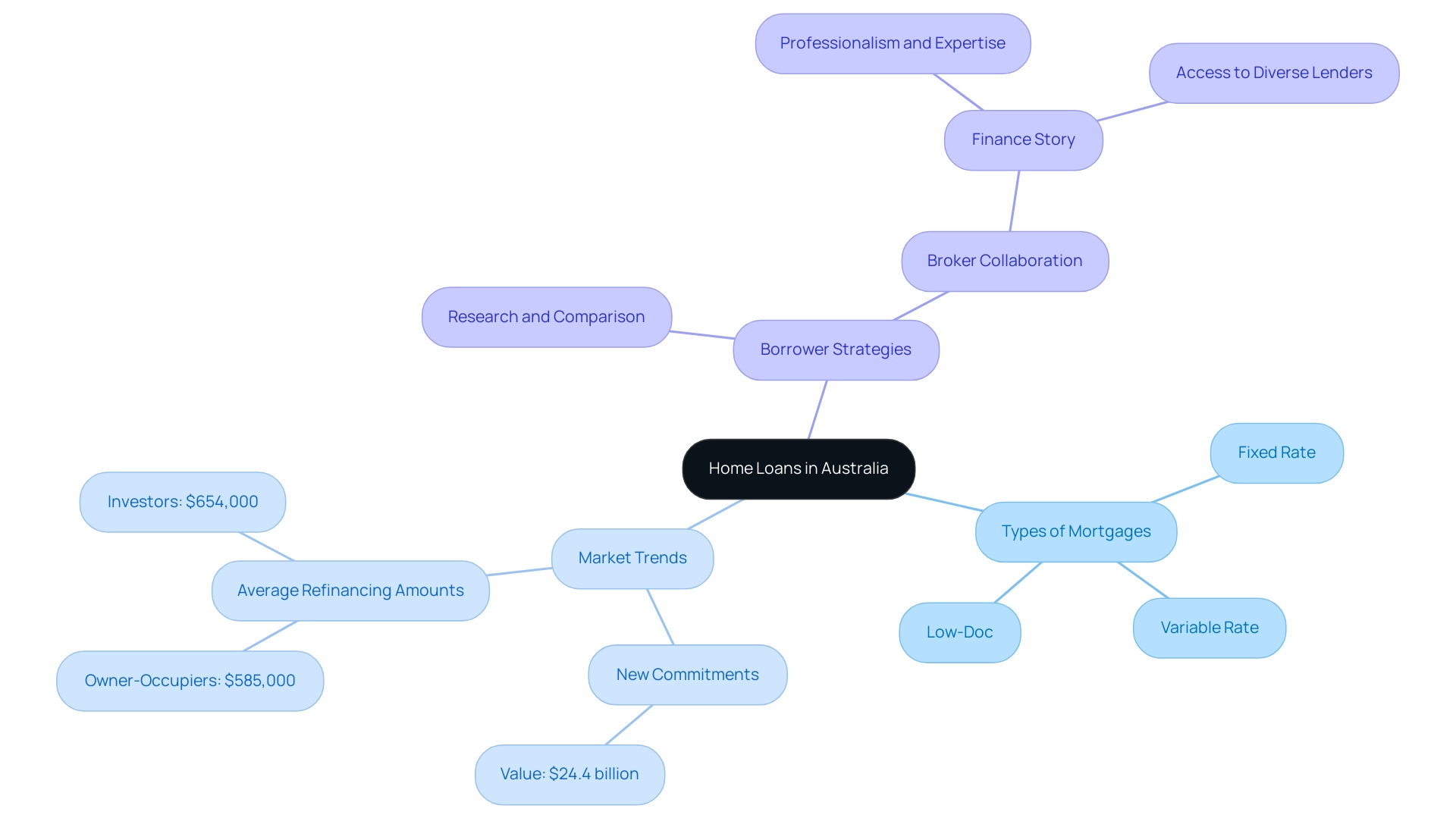
The Role of Mortgage Brokers in Home Loan Selection
Mortgage brokers serve as vital intermediaries between borrowers and lenders, streamlining the housing financing process for clients. They conduct thorough evaluations of clients' financial situations, recommend appropriate credit products, and negotiate favorable terms with lenders on their behalf. In Australia, the prominence of home loan providers has surged, with approximately 60% of home financing facilitated through these professionals, underscoring their growing influence in the market.
The role of mortgage brokers transcends basic facilitation; they offer invaluable expertise that empowers borrowers to access a wider range of options and potentially secure better rates than they could on their own. Finance Story exemplifies this commitment to client-focused service, providing tailored mortgage brokerage solutions for both commercial and residential financing, even in challenging scenarios. As highlighted by industry experts, brokers prioritize their clients' needs, ensuring that the financial products recommended align with individual financial circumstances.
This dedication is reinforced by the best interests duty, which requires brokers to concentrate on what is most advantageous for their clients.
As seasoned mortgage broker Donna Campbell articulates, "Ultimately, it's a client's decision on where they choose to go, and we focus on what best fits their needs, in terms of products and what they seek from a mortgage and all that kind of thing." This statement emphasizes the broker's role in facilitating informed client choices, a principle that Finance Story embodies through its bespoke mortgage services.
The mortgage broking industry in Australia has witnessed robust growth, with a compound annual growth rate (CAGR) of 6.6% projected between 2019 and 2024. This growth reflects the increasing reliance on brokers for navigating the complexities of financing a residence with home loan providers. Additionally, the establishment of referral networks is essential for new independent brokers, while those affiliated with franchises benefit from pre-existing connections, enhancing their capacity to serve clients effectively.
Industry partners have contributed to this report, showcasing the collaborative effort in emphasizing the mortgage and finance broking industry's value.
Finance Story offers a straightforward three-step guide to securing the best residential financing, streamlining the process for small business owners. Testimonials from satisfied clients, such as Natasha B. from VIC, highlight the positive impact of Finance Story's services: "I will definitely be recommending your business to anyone. We are finished with the constant worry. Once again, thank you so much for being a part of our journey." This underscores the significance of brokers in the property financing process, particularly as they adapt to meet the diverse needs of borrowers in 2025 and beyond. With Finance Story, obtaining the finest residential financing becomes a seamless experience, enhanced by tailored support and access to leading market offerings, backed by a comprehensive portfolio of private, boutique commercial investors and standard funding sources.

Types of Home Loan Providers in Australia
In Australia, home loan providers are primarily categorized into three distinct types: banks, credit unions, and non-bank lenders. Each category presents unique advantages and challenges that individuals should consider when seeking financing.
-
Banks are the most traditional providers in the market, offering a comprehensive range of products and services. They typically have extensive resources and established reputations, instilling confidence in those seeking loans. However, home loan providers often impose stricter lending criteria, which may limit access for some applicants.
-
Credit unions, on the other hand, are member-owned institutions that prioritize customer service and community engagement. They frequently offer competitive interest rates and personalized service, making them an appealing choice for individuals seeking a more tailored approach. The recent KPMG survey indicates that 80% of leaders in Australia’s mutual banks believe reducing customer friction will enhance the overall experience, highlighting the commitment of credit unions to improve service delivery.
-
As Stephanie Elliott, Chief Operating Officer of the Customer Owned Banking Association, notes, "A customer-owned bank is different because it doesn’t have the conflict between what's good for the bank's owners and what's good for the bank's customers. This means that these banks exist only to serve their customers."
-
Non-bank lenders have experienced substantial growth in the Australian mortgage market, especially due to their adaptable lending standards and creative offerings. These providers often cater to borrowers who may not meet the traditional requirements set by banks, offering alternative solutions that can be more accessible. As of 2025, non-bank lenders are increasingly capturing market share, driven by their ability to adapt to changing consumer needs and preferences.
In this landscape, discussing your next housing finance with Finance Story is as simple as 1, 2, 3. They save you time and effort by doing the hard work to find the best value products on the market. With personalized support, Finance Story can meet with you at a time that fits your busy life, assisting you in determining what is essential for your next home financing.
Their expertise and access to the latest products ensure that you receive tailored guidance in navigating the options available.
The market dynamics reveal that owner-occupied mortgages have become the largest product segment in the industry, largely due to government initiatives like the First Home Guarantee, which have stimulated demand despite challenges in mortgage affordability. This trend has prompted credit unions and building societies to expand their offerings of personalized loan services, further enhancing their competitive edge.
In terms of market share, banks still dominate the landscape, but the rise of non-bank lenders is reshaping the competitive environment. As individuals become more informed and seek out the best deals, the differentiation between these providers becomes increasingly important. Success stories abound, with many individuals finding favorable terms and conditions through non-bank lenders, illustrating the potential benefits of exploring all available options.
Currently, home loan interest rates are at 5.14%, which adds another layer of consideration for individuals seeking loans. Ultimately, the choice between banks, credit unions, and non-bank lenders will depend on individual circumstances and preferences. It is also important to note that this platform does not cover every product or provider in the market, and users are encouraged to seek independent advice.
By recognizing the strengths and weaknesses of each provider type, individuals can make informed choices that align with their monetary objectives.
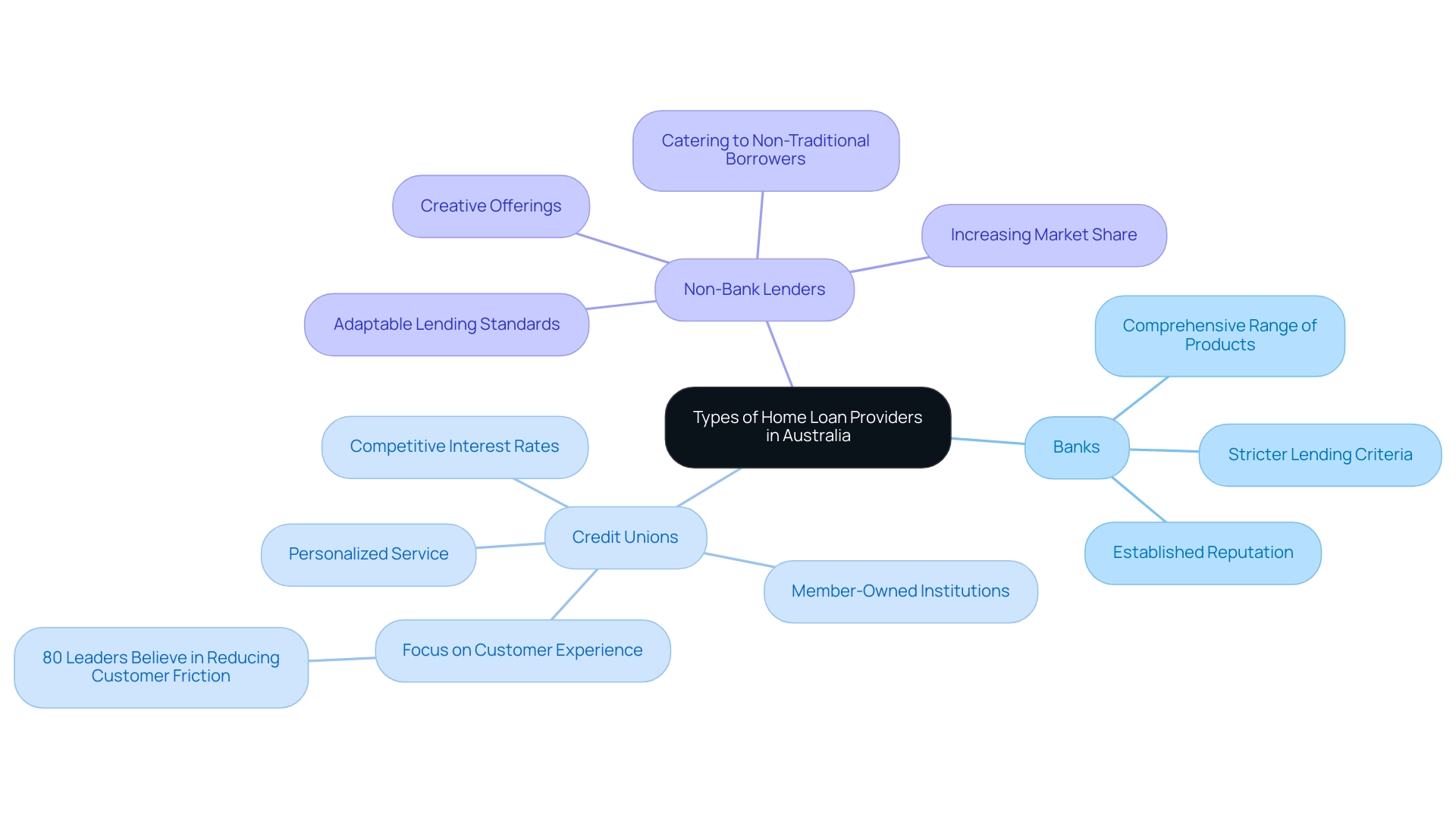
Key Features to Consider When Comparing Home Loans
When assessing home financing options, it is crucial for individuals to consider several essential aspects that home loan providers in Australia can offer, as these can significantly impact their financial outcomes. Key considerations include interest rates—both fixed and variable—loan terms, repayment options, and any associated fees. Fixed interest rates provide stability in repayments, while variable rates may present lower initial costs but can fluctuate over time, affecting long-term affordability.
Furthermore, features such as offset accounts and redraw facilities play a significant role in managing borrowing costs. Offset accounts, which allow individuals to reduce the interest owed on their debts by linking their savings, have surged in popularity, with total balances exceeding $300 billion in late 2024. This trend underscores their effectiveness in helping individuals save on repayments.
According to the Australian Bureau of Statistics, the average mortgage size in Australia is $666,000, emphasizing the importance of these features in managing substantial borrowing amounts.
In addition, the ability to make extra repayments can provide flexibility and assist in reducing the overall interest paid throughout the financing duration. Financial advisors often stress the importance of these features, noting that they can significantly enhance an individual's financial strategy. As of 2025, average interest rates for fixed mortgages are typically higher than those for variable options, reflecting the trade-off between stability and potential savings.
Individuals should also be aware of common charges associated with residential financing offered by home loan providers in Australia, such as application costs, ongoing expenses, and discharge fees, which can elevate the total expenditure.
For those considering refinancing, it is generally recommended that individuals possess at least 20% equity to avoid paying lenders mortgage insurance (LMI), offering practical guidance for those looking to reevaluate their financing options. By thoroughly understanding these features and their implications, borrowers can make informed decisions that align with their financial goals and repayment capabilities, ultimately leading to a more favorable borrowing experience. With Finance Story's tailored assistance and access to premier products, small business proprietors can navigate these challenges effortlessly, ensuring they discover the best mortgage solutions customized to their needs.
Talking to us about your upcoming mortgage is as simple as 1, 2, 3. We can meet with you at a time that suits your busy life, allowing us to handle all the hard work in finding the very best value products on the market.
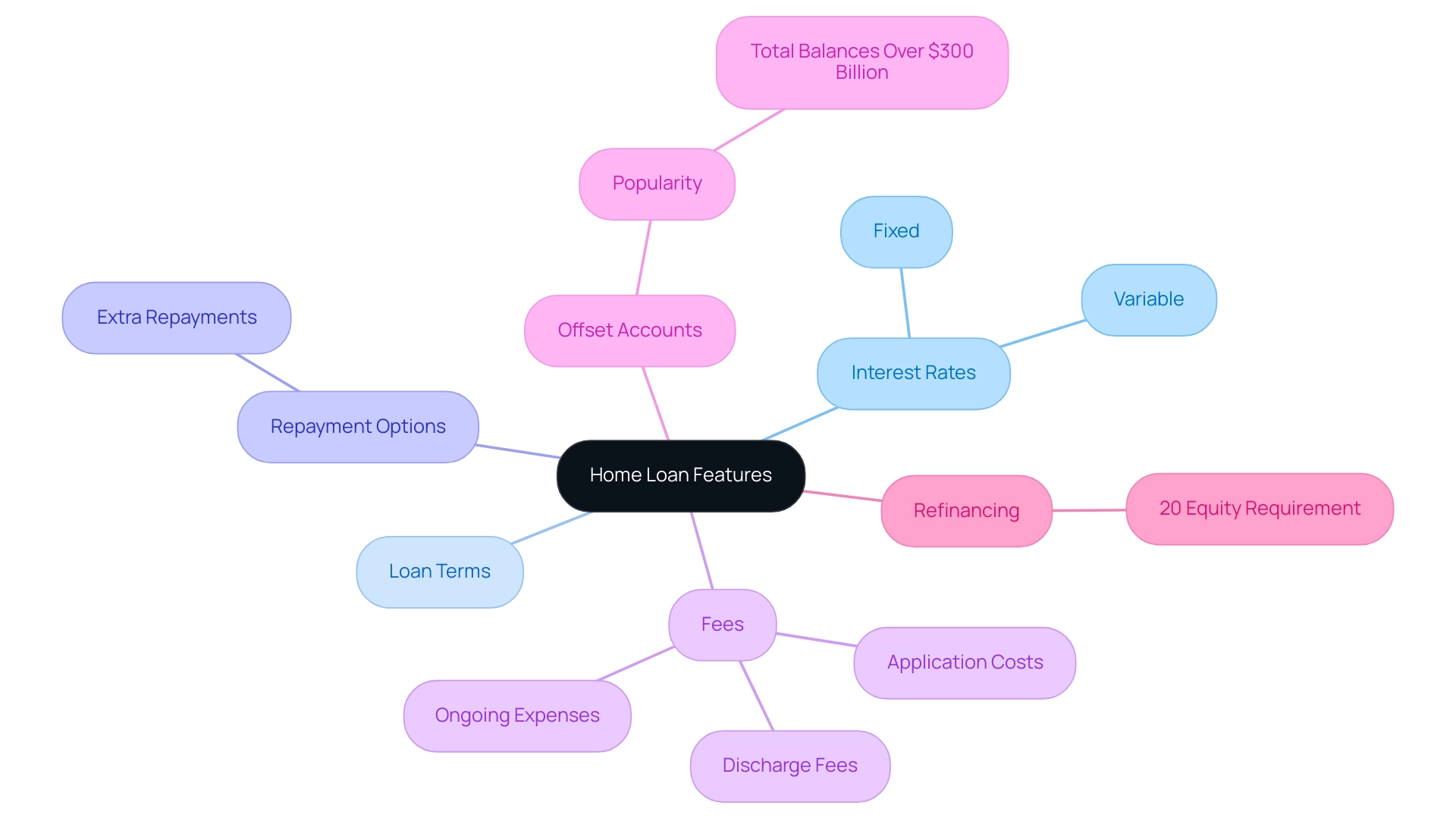
Financial Considerations: Interest Rates and Fees
Interest rates are pivotal in the decision-making process for residential financing, as even a slight change can lead to substantial savings over the financing term. As of March 2025, average interest rates for residential mortgages in Australia are shaped by various factors, including the Reserve Bank of Australia's monetary policy and prevailing market conditions. Current rates are competitive, with numerous lenders offering rates that can significantly affect the total cost of borrowing.
In addition to interest rates, individuals seeking financing must consider a range of fees associated with home financing. These fees can include:
- Establishment fees charged at the beginning of the agreement
- Ongoing fees that may apply throughout the term
- Exit fees incurred when paying off the loan early
Understanding these costs is crucial, as they can accumulate and influence the total amount payable over time. Recent data shows that the average new owner-occupier lending amount, including refinancing, stands at approximately $665,978 as of February 2025.
Furthermore, the Australian Bureau of Statistics reports that the average mortgage size across Australia is $666,000. This figure underscores the importance of evaluating the overall expense of financing, which encompasses both interest and fees, to identify the most cost-effective option available. Experts advise caution regarding hidden fees that may not be immediately apparent.
These can include charges for:
- Valuation services
- Legal fees
- Fees for making additional repayments
A thorough review of the financing agreement is essential to avoid unexpected costs that could arise later.
Real-life examples demonstrate the impact of interest rates and fees on home financing costs. For instance, a borrower who secures financing with a 0.5% lower interest rate could save thousands over the life of a 30-year mortgage. Additionally, comparing various lenders' fee structures can uncover significant discrepancies that further influence the overall cost of borrowing.
Finance Story, a Melbourne-based boutique mortgage brokerage, specializes in providing tailored financial solutions for both commercial and residential clients. Their expertise in navigating the complexities of residential financing can be invaluable for small business owners seeking personalized support and access to the best market products. By streamlining the housing financing process, Finance Story ensures that clients can focus on what matters most while securing the best value products available. Let us handle the hard work in finding the optimal housing financing options for you.
Contact us today to discover the best home loan solutions tailored to your needs. In summary, when selecting home loan providers in Australia, it is vital to conduct a thorough comparison of both interest rates and associated fees. This approach not only aids in identifying the best deal but also ensures that individuals are fully informed about the financial commitments they are undertaking. Moreover, understanding the average mortgage sizes across various Australian states—such as $811,000 in New South Wales and $650,000 in the ACT—can provide further context for borrowers as they evaluate their options.
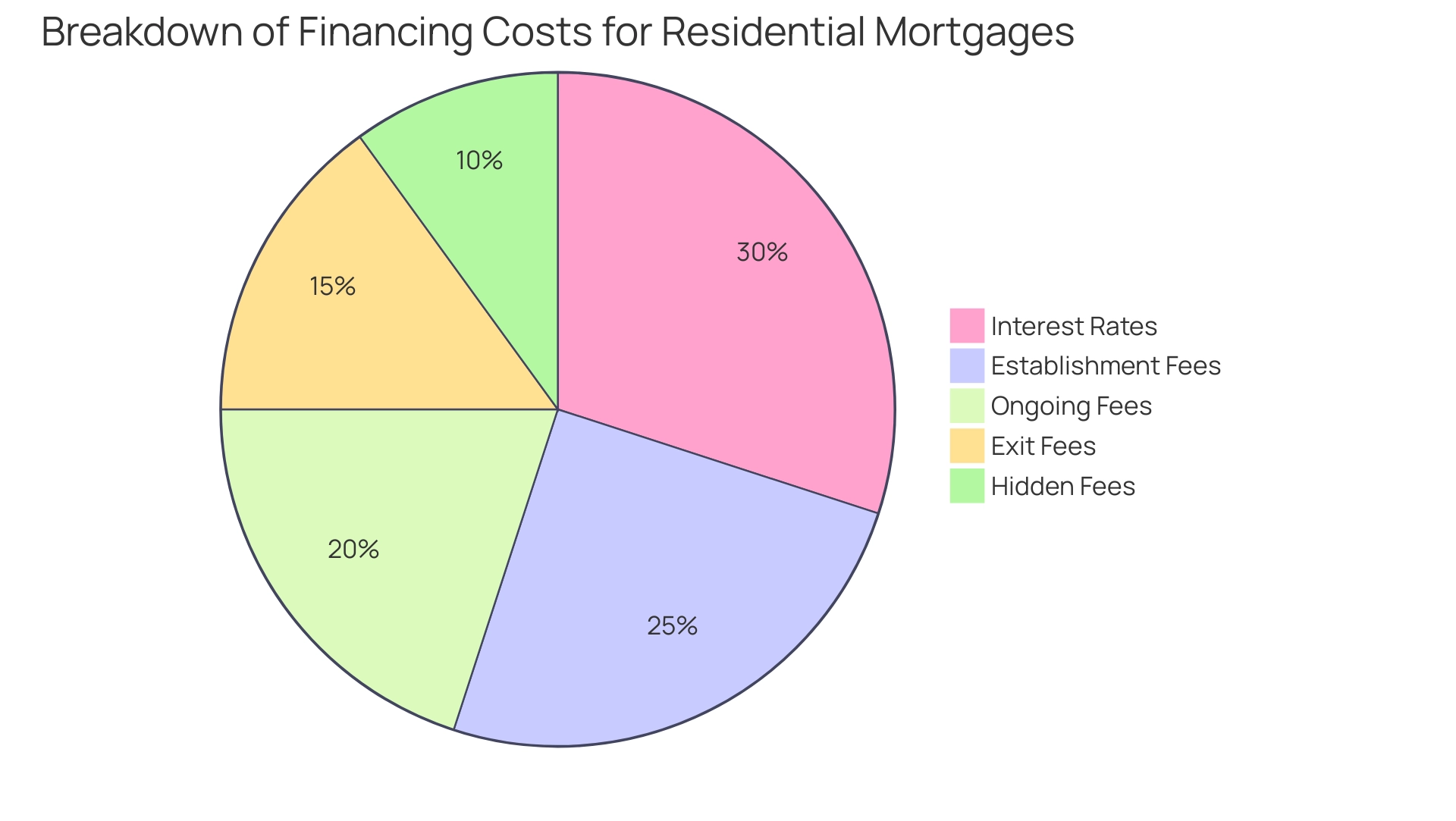
Market Trends and Regulatory Changes Affecting Home Loans
The Australian housing credit market is shaped by various factors, including economic conditions, fluctuations in interest rates, and significant regulatory changes. As of December 2024, the average mortgage amount for owner-occupiers reached a record high of $666,000, with some states reporting averages as high as $811,000. This trend highlights the increasing financial commitment required from borrowers.
Talking to us about your upcoming mortgage is as simple as 1, 2, 3.
Recent developments indicate a notable shift towards more flexible lending practices. Home loan providers in Australia are increasingly adapting to the diverse needs of clients, particularly in response to government programs designed to assist first-time property purchasers. These initiatives often involve easing lending criteria, which can significantly reshape the overall lending landscape.
For instance, regulatory changes have introduced measures that enhance transparency and accountability in lending, ultimately benefiting consumers by fostering a more competitive environment. According to a 2024 InfoChoice survey, 44.8% of Australians have a mortgage, while another 16.6% own a home and have fully paid off their mortgage. This statistic underscores the prevalence of mortgages in Australia and the importance of understanding current market dynamics.
Staying informed about these trends is essential for individuals seeking advantageous financing conditions from home loan providers in Australia. The current market dynamics suggest that grasping the implications of regulatory changes can empower borrowers to make informed decisions regarding home loan providers. For example, recent modifications in borrowing regulations have simplified the qualification process for individuals with non-traditional income sources, thereby broadening access to property ownership.
Furthermore, the ongoing evolution of the mortgage market, driven by home loan providers in Australia, reflects broader economic trends, including shifts in consumer behavior and preferences. As the landscape continues to change, case studies reveal that mortgage brokers, such as Finance Story, are playing a pivotal role in navigating these complexities. Finance Story's commitment to offering efficient residential financing solutions, personalized assistance, and access to a variety of lenders enables clients to identify the most suitable funding options, even in challenging circumstances.
We strive to find the best value products tailored to your needs and can meet with you at a time that fits your busy life. Their innovative approach not only enhances the borrowing experience but also positions clients to capitalize on favorable market conditions, as evidenced by client testimonials highlighting exceptional service and support throughout the financing process.
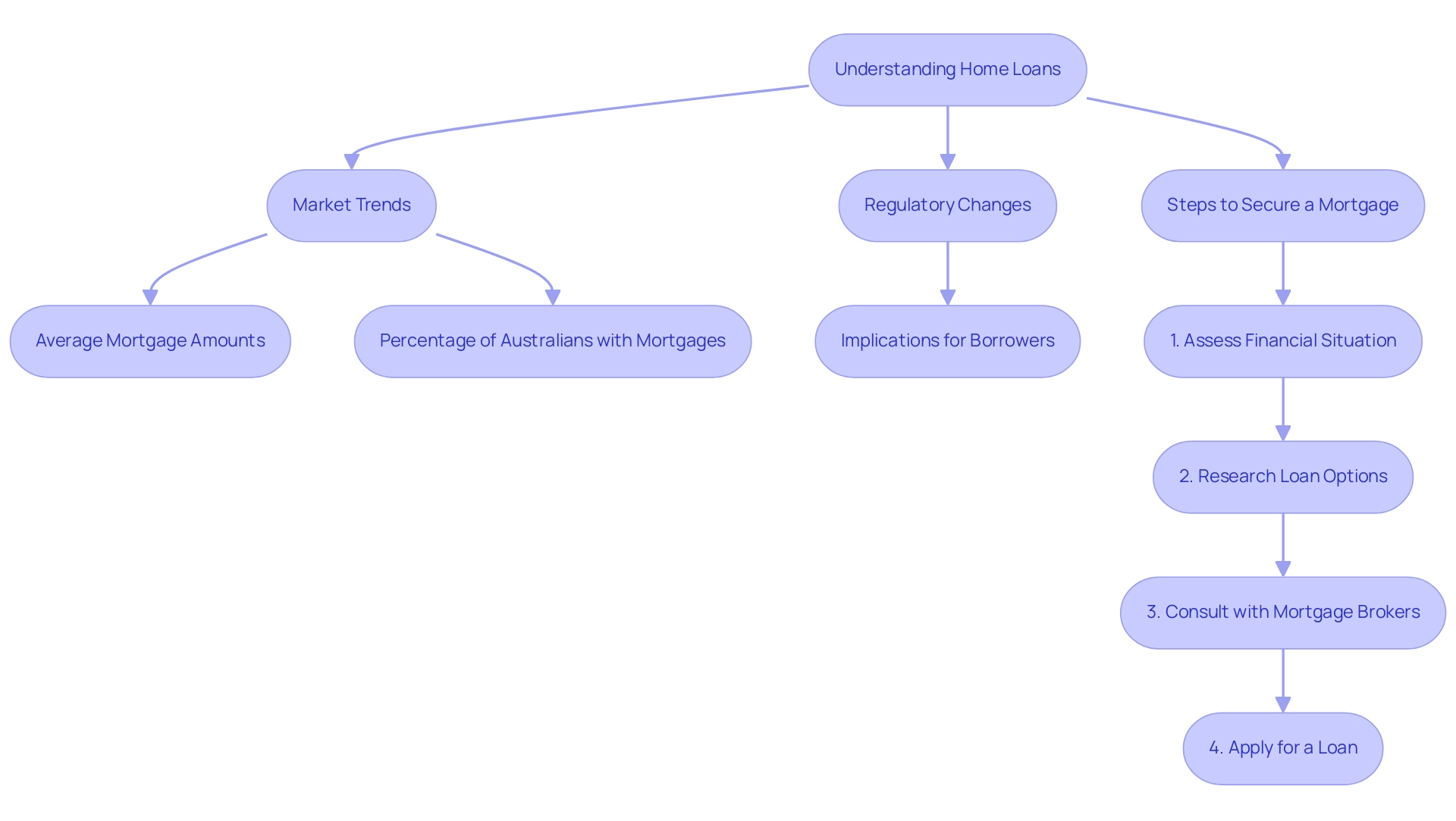
Evaluating Customer Service and Support from Lenders
Customer service plays a pivotal role in the housing financing process provided by home loan providers in Australia, as clients often seek guidance and support at various stages of their financial journey. A lender's responsiveness, transparency, and willingness to assist can significantly influence the overall borrowing experience. Recent statistics indicate that the value of new owner-occupier first home buyer loan commitments for dwellings rose by 1.5% in the December quarter of 2024, underscoring the growing demand for effective lender support.
However, it is crucial to acknowledge that data quality concerns persist for alterations and additions series, which have been revised downwards in recent quarters. This highlights the need for individuals to be discerning in their choices.
To evaluate lenders effectively, individuals should consider reviews and testimonials from previous clients, offering valuable insights into the quality of service provided. For instance, testimonials from satisfied clients like Natasha B. from VIC reflect how Finance Story has distinguished itself through its innovative lending solutions and adaptability in the lending process. She expressed, "I will definitely be recommending your business to anyone. We are finished with the constant worry. Once again, thank you so much for being a part of our journey." By accessing a diverse portfolio of private lenders and boutique commercial investors, alongside mainstream banking institutions, Finance Story presents clients with tailored options that meet their unique circumstances.
This comprehensive approach not only enhances client satisfaction but also positions the brokerage as a leader in the finance sector, adept at navigating challenging financial situations and ensuring positive experiences.
Moreover, the significance of customer service in choosing a mortgage provider cannot be overstated. As the landscape of home loan lending evolves, particularly in 2025, individuals must prioritize home loan providers in Australia who demonstrate a commitment to exceptional service. Evaluating lender support and responsiveness is essential; borrowers should inquire about the availability of assistance from home loan providers during the application process and beyond.
As Roy Morgan observes, retail banking customer satisfaction in Australia is facing challenges due to a transition to digital interactions at a crucial moment when customers in poor economic conditions require additional support from banks. By concentrating on these factors, small business proprietors and individuals can make informed choices that align with their monetary objectives and ensure a smoother borrowing experience. Finance Story, with offices in Melbourne and the UK, is committed to providing innovative and tailored mortgage brokerage solutions for commercial and residential financing in challenging circumstances.
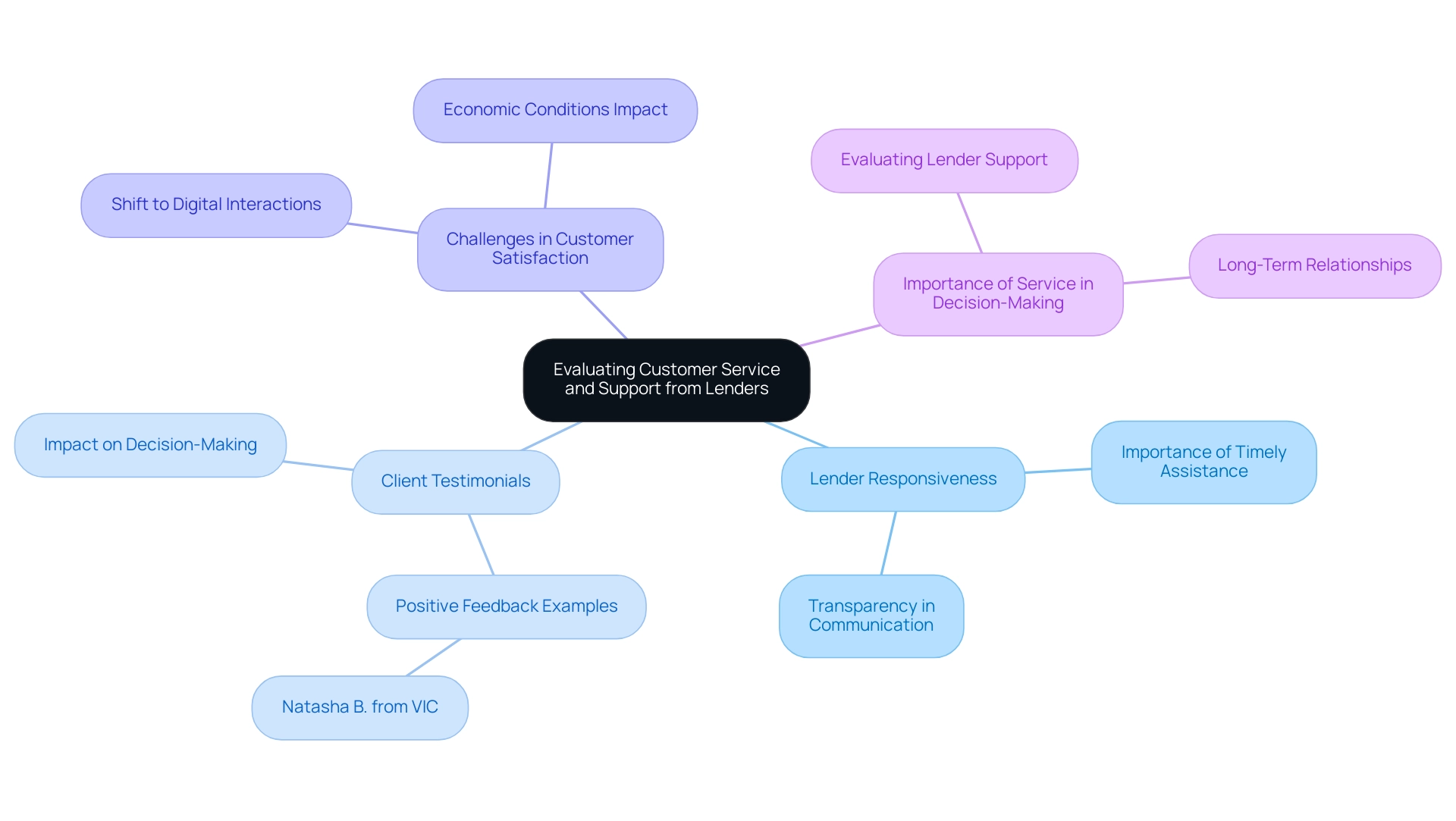
Making an Informed Decision: Choosing the Right Home Loan Provider
Choosing the right home loan providers in Australia is a pivotal decision that demands a thorough evaluation of crucial factors such as financing features, interest rates, fees, and customer support. By conducting a detailed comparison of various home loan providers, individuals can identify the most suitable options tailored to their financial situations.
Research reveals that in March 2023, the value of owner-occupier external refinancing reached an impressive $41.193 billion, highlighting the importance of informed decision-making in the home financing market. This statistic underscores a growing trend among borrowers who are increasingly seeking better terms through diligent comparison. Moreover, since July 2019, financial commitments for residential land have been recorded separately for owner-occupiers and investors, offering deeper insights into the lending landscape.
To make an informed choice, it is essential to invest time in investigating and assessing various options from home loan providers in Australia. Prioritize factors such as the flexibility of financing features, the competitiveness of interest rates, and the transparency of fees. Additionally, the quality of customer service can significantly impact the borrowing experience, making it vital to consider lenders known for their supportive and responsive service.
Optimal strategies for selecting home loan providers in Australia include:
- Utilizing online comparison tools
- Reading customer feedback
- Seeking expert financial advice
Perspectives from industry experts, like Harry O'Sullivan, emphasize the importance of understanding how various credit products align with personal financial goals: "Wondering how your investment portfolio compares to the rest of Australia? Here’s what the research says."
A case study featuring Finance Story illustrates the brokerage's innovative lending process, demonstrating its capability to navigate complex financial situations. By leveraging a diverse range of private lenders and mainstream institutions, Finance Story effectively tailors options to meet unique client needs, particularly for small business owners seeking commercial property funding or business financing. This enhances its reputation for professionalism in the finance sector.
To further assist you in selecting the right mortgage provider, we invite you to schedule your free personalized consultation with Finance Story's Head of Funding Solutions, Shane Duffy. This consultation will provide you with customized guidance on managing your specific financial circumstances, whether for business or personal needs. Discuss your objectives, and let us help you create your next chapter.
Please choose a convenient time from our live calendar. Ultimately, the time required to compare home loan providers in Australia may vary, but dedicating adequate time to this process can yield substantial long-term benefits. By following these guidelines and seeking expert advice, borrowers can confidently select the right home loan providers in Australia that align with their financial aspirations.
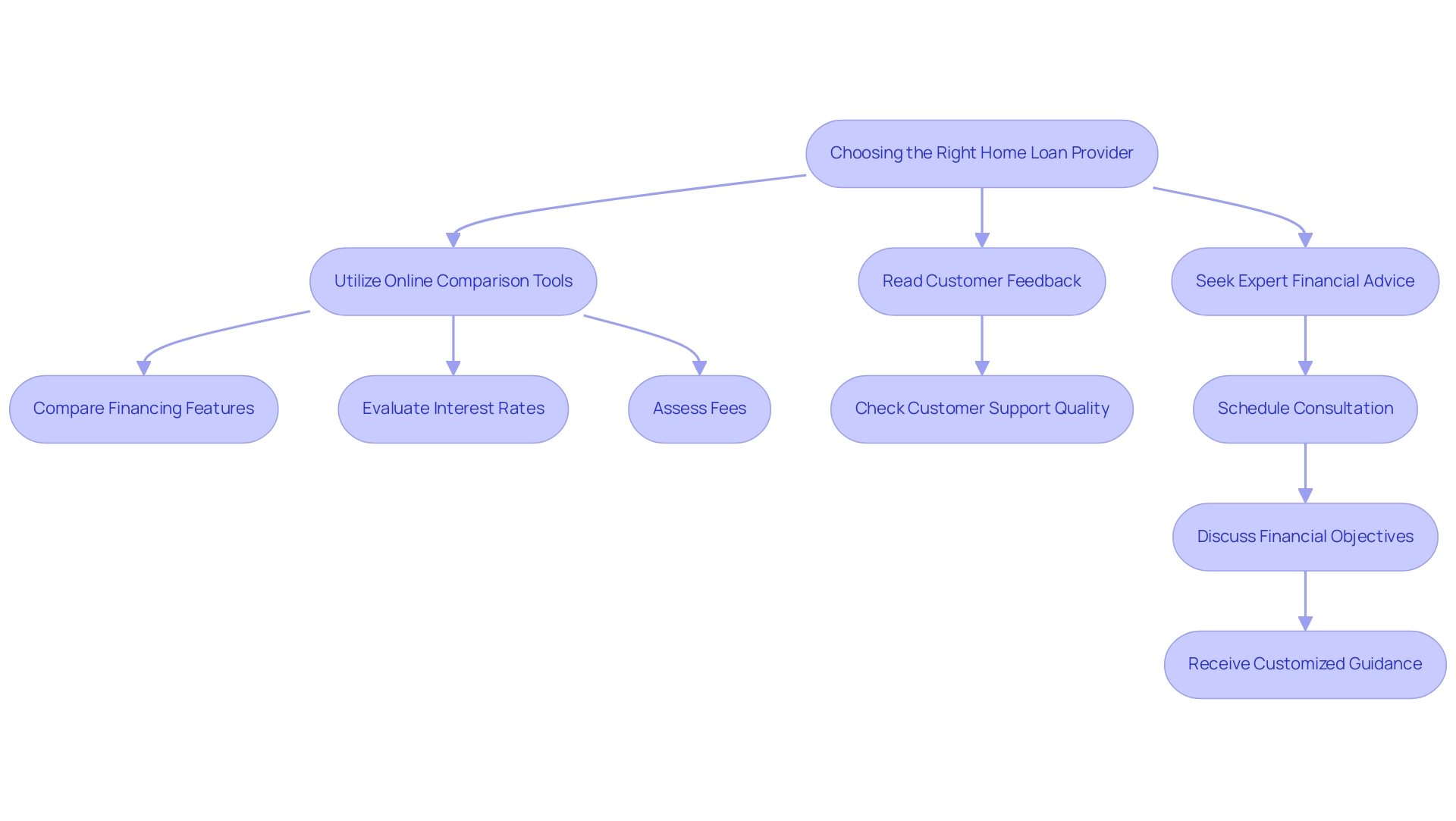
Conclusion
Navigating the Australian home loan market demands careful consideration and informed decision-making. This article has thoroughly explored key aspects such as:
- The variety of home loan products
- The role of mortgage brokers
- The importance of customer service
Understanding the different types of lenders—banks, credit unions, and non-bank lenders—enables borrowers to assess which option aligns best with their individual financial needs and circumstances.
As the landscape evolves towards greater flexibility and innovation, staying abreast of current trends, interest rates, and associated fees is essential for borrowers aiming to secure favorable terms. The insights provided emphasize the necessity of thorough research and comparison, as well as the benefits of engaging with knowledgeable mortgage brokers like Finance Story. Their expertise not only simplifies the borrowing process but also enhances the likelihood of finding optimal financing solutions tailored to personal goals.
Ultimately, making an informed choice about a home loan provider can significantly affect financial well-being. By prioritizing factors such as loan features, customer service, and overall lender responsiveness, individuals can navigate the complexities of home loans with confidence. As the market continues to adapt to changing consumer needs, the importance of understanding and leveraging available resources cannot be overstated. Empowered decision-making today lays the foundation for a successful home-buying experience tomorrow.

